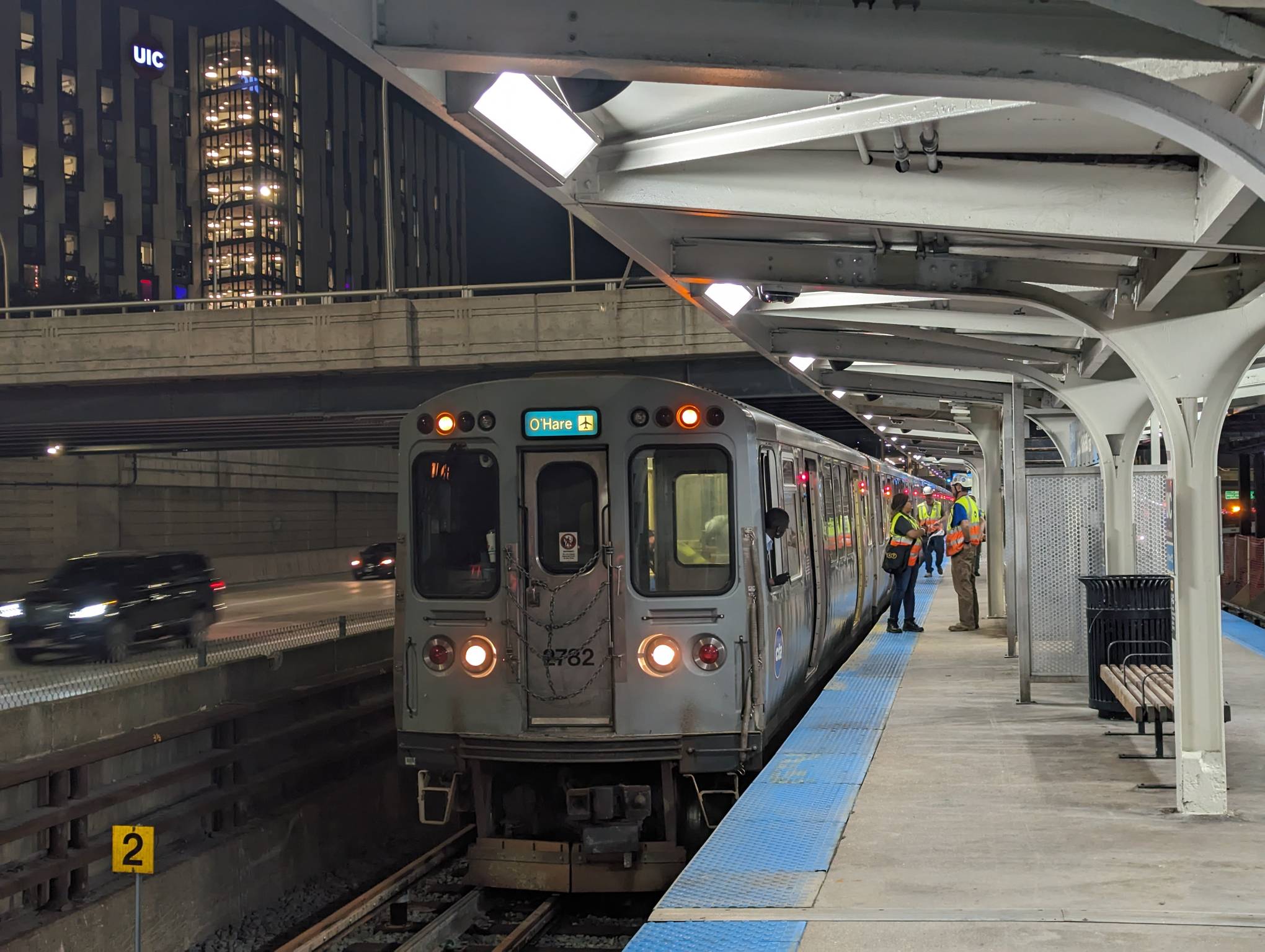
Last Wednesday August 15, the CTA announced details on Part B of the $268 million project to upgrade the Forest Park Branch of the Blue Line between the LaSalle (130 W.) and Illinois Medical District (1900 W.) stations. That segment is dubbed Phase 1 of the larger branch rehab goal. Phase 1 includes completely overhauling 15,000 feet of track, rebuilding the Racine station (1200 W.), and updating the the traction power system, and the project is slated to be mostly finished by October 7.
Part A, which started on July 23, included the rebuild of the stretch between the LaSalle and UIC-Halsted (800 W.) stations. Then starting at 10 a.m. last Sunday, August 20, Blue Line trains resumed serving the Clinton (530 W.) and UIC-Halsted stations via the new tracks.
Yesterday, Monday August 21, Part B, which includes track reconstruction between UIC-Halsted and IMD, plus the Racine station rebuild, fully kicked in. Reflecting the partially restored rail service, the CTA stopped running the rush hour Blue Line Express shuttle bus between the IMD and Jackson (300 S., located on Dearborn Avenue, 30 W.) stops that operated during Part A. However, the agency is still operating free 24/7 Blue Line Local shuttles along the current roughly one-mile track work area between the UIC-Halsted and IMD stops.

To make the line closures easier on affected Blue Line riders, the CTA has also been offering free and reduced-price rides on relevant rail and bus lines, which is continuing through October. Check out this article for details on how this program works. Last Wednesday CTA announced that Pace Suburban Bus is also helping out by offering free rides on some of its north-south fixed route buses in the project area.
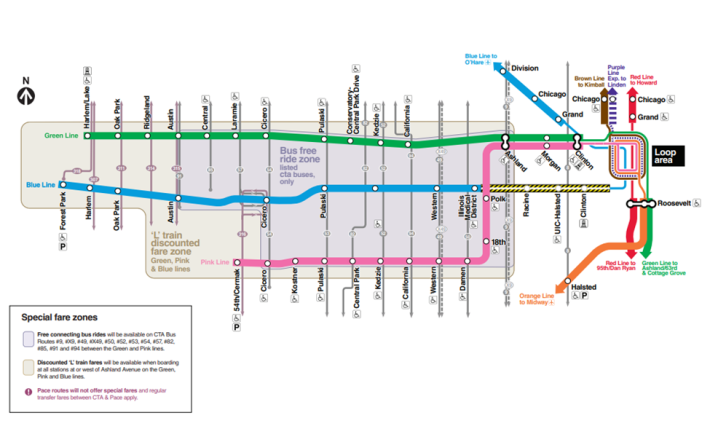
Last week the grassroots advocacy group Commuters Take Action (CTAction) praised the agency for the progress made on the Forest Park Branch rebuild, including opening UIC-Hasted in time for fall University of Illinois Chicago classes. But as they have since the project was announced, CTAction asked for more transparency from the CTA about how the work is affecting riders, and voiced a few other concerns.
Here's a recap of Commuters Take Action's queries and comments from last week that Streetsblog shared with the CTA, responses from the agency's media department we received last Friday, and reactions from CTAction cofounder Fabio Göttlicher yesterday (in italics after portions of the media department's response.) Streetsblog's edits to the text for clarity and our commentary are in brackets.
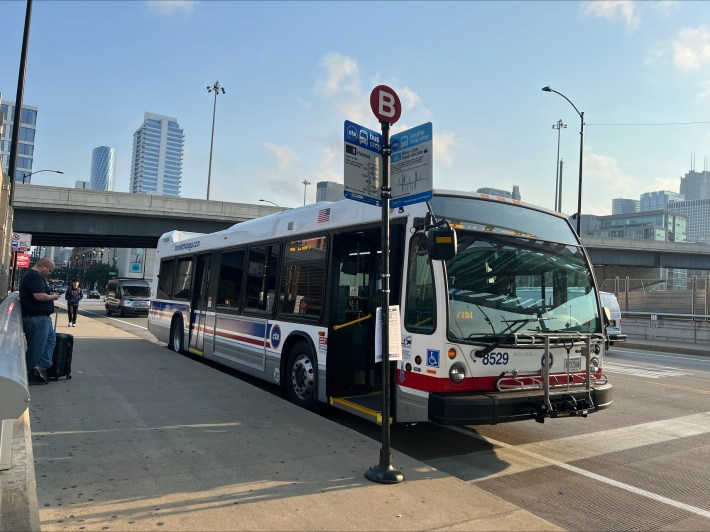
CTAction questions/comments #1:
"How often [will] Blue Line service run between UIC and O'Hare after [Sunday, August 20, when Blue Line trains start traveling to the Clinton and UIC-Halsted stops again]?”
[During Part A, the CTA cut Blue Line service by 14 percent, according to data from the CTA's General Transit Feed Specification public data website.] "We're unsure whether the service reduction will continue in Part B.”
"If a rider needs to use the replacement shuttle bus, it's near impossible to plan out the travel time needed – once again the CTA has shared very little in terms of shuttle travel times and frequency."
CTA Media's response #1:
"During these [Part B] service changes [resumption of Blue Line service to Clinton and UIC-Halsted], bus shuttles will be operating at the same frequency of scheduled [train] service. Depending on the time of day, the Bus shuttle will operate every 5-15 minutes on weekdays and 10-15 minutes on weekends."
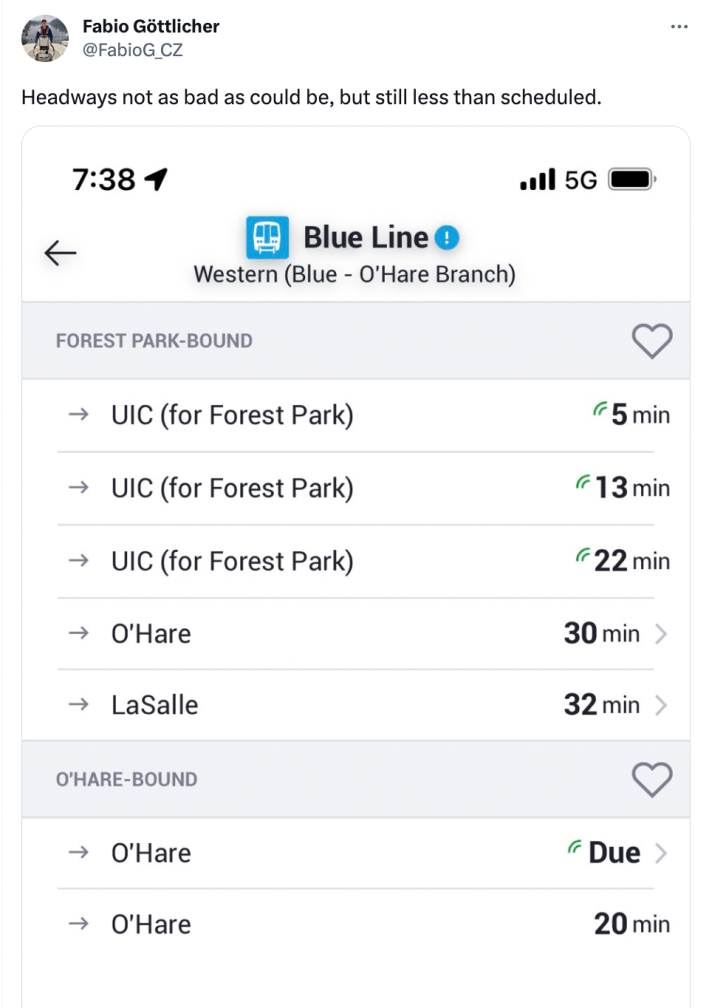
This morning Fabio Göttlicher tweeted about the wait times for trains while "testing out the Blue Line shuttle for Part B of Phase 1 of Forest Park Rebuild. Traveling from Western [on the O'Hare Branch] to IMD."
CTAction questions/comments #2:
"[The scheduled] re-opening of the turn-around track at UIC-Halsted should allow CTA to run trains more frequently.”
[However, CTAction later told Steetsblog the following.] "From our observations, it appears that the UIC/Morgan turnaround track will likely not be finished by July 20. If that's the case, we are worried about the CTA being able to reliably dispatch trains all the way to UIC with the nearest crossover being just east of the LaSalle station. We are hoping that the CTA has a solid plan for operations and would be interested to hear more details about it.”
CTA Media's response #2: [No response.]
CTAction questions/comments #3:
"It's embarrassing that station schedules and [the schedules on the CTA's "Blue Line 'L' webpage] have no mention of service changes."
[CTAction said they would like there to be pre-recorded service change announcements on the 'L', instead of relying on train operators to make these announcements themselves.] "Digital signage on trains and at stations should have also been updated."
CTA Media's response #3:
"In preparation for this project CTA has carried out comprehensive communication efforts. This has included press releases, social media promotions, customized breadcrumb signage plans for each location, a dedicated webpage, project brochures, updated neighborhood maps for stations within the project footprint and more. In addition, for Phase 1 Part A work, CTA also deployed Information Specialists in and around Blue Line stations the week prior to and after project work began, to hand out brochures, assist customers with changes in service, and direct them to the available shuttle buses to continue their journeys."
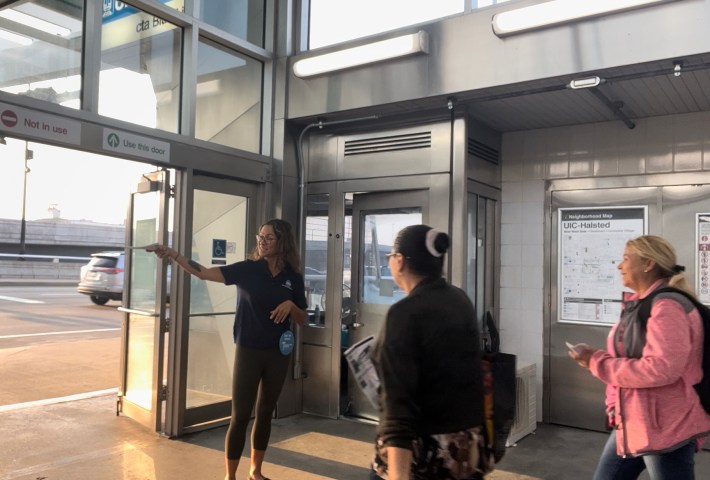
Reactions from CTAction cofounder Fabio Göttlicher: "We recognize that CTA's efforts in rider education have been much better than in the past, so there is definitely credit deserved. But as an advocacy organization, we're always striving to push the CTA to be better."
"There have been announcements made over station PA systems and by train operators via the PA systems on the trains and shuttle buses. CTA decided that it was most effective to have rail operators manually make the announcements for both parts of Phase 1 work."
Reaction from Göttlicher: "We don't understand how it could be argued that [having rail operators manually make the announcements] would be more effective. Pre-recorded announcements would have been easier to hear and understand, would ease the load on operators and eliminate any potential for human error. A personal example: I was on the Blue Line [O'Hare branch] from California to LaSalle last week (during part A.) A couple of tourists wanted to take the train to LaSalle as well. The operator on the train misspoke when making an announcement, and said Jackson would be the last stop (instead of saying it is the station to board the shuttle buses). This left the folks confused and I had to reassure them that the train goes all the way to LaSalle."
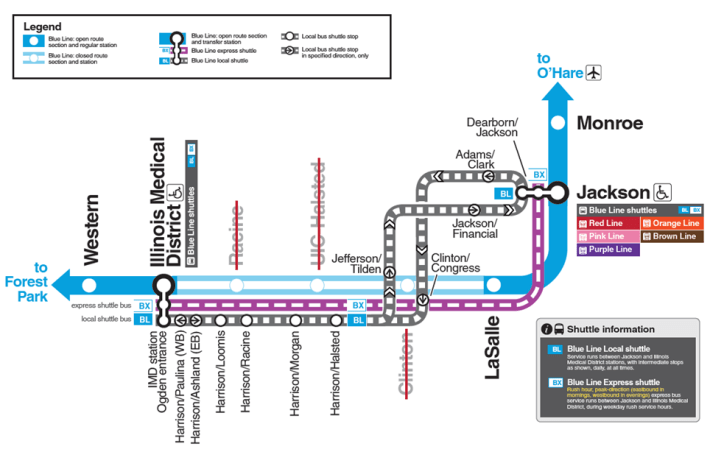
"Moreover, CTA has closely coordinated with the many stakeholders in the affected area, including elected officials, schools and the Illinois Medical District."
"The digital signage on the system has shown alerts that explain the linecut [truncated service in the middle of a rail line] for this project. However, we choose not to change destination signs on trains to avoid causing confusion for riders. By changing the destination signs to indicate their terminating at the shorter, temporary terminals there is a chance it would cause confusion for riders, resulting in them letting the trains pass them by when they should choose to get on the next available train."
Reaction from Göttlicher: "We think [changing destination signs on trains] could have been [a more sensible way] to let riders know about changes. They could've kept Forest Park/O'Hare signage for early-terminating trains, but maybe the background color could've been changed, or the shown destination could've rotated between LaSalle/Forest Park and IMD/O'Hare on the digital signs. The fact that since [Sunday, August 20], trains from O'Hare to UIC -Halsted are showing the "UIC" destination sign makes the CTA statement [about choosing not to change destination signs on trains] inconsistent. Digital boards inside of 7000-series trains did not show anything related to the service having changed. I'd have hoped that brand new, 'state of the art' trains would have made that easily possible."
Our crews have been working around the clock since July 23 to complete the first part of the Forest Park Branch Rebuild. Late this Sunday, August 20, the tracks between LaSalle and UIC-Halsted will be reactivated as we move to Part B. pic.twitter.com/Lf61KmRwnb
— cta (@cta) August 18, 2023
"The Train Tracker also provided the necessary information and had links to alerts that would appear when customers pull up results that would explain the linecut."
Reaction from Göttlicher: "For the first several weeks, the Train Tracker destinations were still listed as "Forest Park" and "O'Hare," and a helpful change to "LaSalle (Jkson for FP)" and "IMD (for O'Hare)" was only made on August 16. With the beginning of Part B, it took the CTA until 9:00 a.m. on August 21 [the day after the Clinton and UIC-Halsted stations reopened] to start showing trains with the UIC destination instead of LaSalle on the tracker. That's not a major complaint by any means, but it just goes to show that not everything is as well planned as the CTA would like us to believe."
"In addition to the above measures, CTA also updated its service information APIs [data for mapping and transit planning apps] to ensure that temporary service impacts planned as part of project work were properly reflected. This allows riders to use [Transit App, Google Maps, Apple Maps etc.] to schedule their travel ahead of time to avoid travel disruptions or delays."
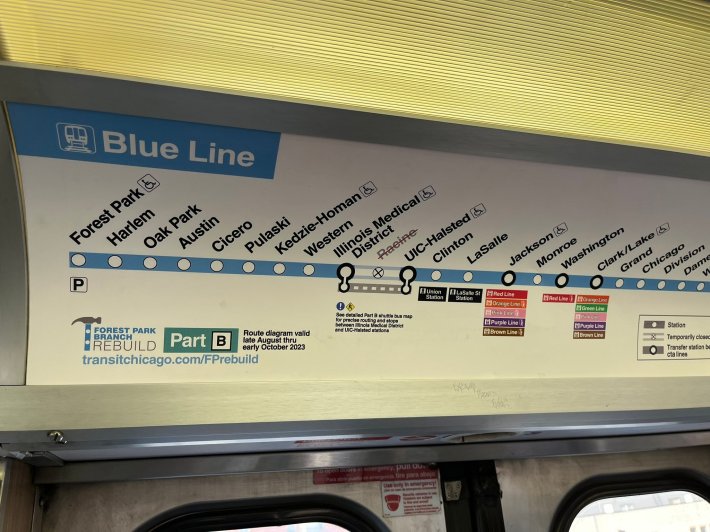
[The CTA Media response concluded with an assertion that the agency has been trying its best to be transparent about how the Blue Line reconstruction will work.] "Every detail of the Forest Park Branch Rebuild project has been thoroughly considered and planned with input from multiple CTA departments, including rail operations, safety, planning/scheduling, and others. Much of this information can be accessed through CTA’s [Forest Park Branch Rebuild] website. The agency has been strongly committed to providing as much information as possible to our customers to make sure that they are knowledgeable about the project and can find the necessary information."
Reaction from Göttlicher: "Missing from the CTA's response is any comment or acknowledgement regarding reduced service or lack of communication about schedules. It's almost customary for the CTA to refuse to comment about service reductions."
So the CTA and and CTAction aren't exactly on the same page about what would have been the best approaches for notifying customers about service changes. But on the bright side, the Clinton and UIC-Halsted stations reopened yesterday without Streetsblog hearing about any major snafus, so it's good that the Forest Park Branch Rebuild seems to be chugging along.

Did you appreciate this post? Please consider making a tax-deductible donation.
